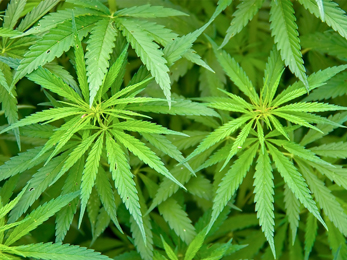Bhanga (Cannabis Sativa)

DESCRIPTION OF THE BHANGA
Bhanga is the ancient medicinal herb, famous with names of Marijuana Indian hemp, Ganja. The scientific name of the plant is Cannabis Sativa. It belongs to the Cannabaceae family. Bhanga is known to be an annual herb with erect stem, grows up to 3 to 10 feet or more than this and slightly branched with greyish green hair. The leaves of the plant are palmate, stipulate, present alternatively, have long petiole, smooth dark green with serrate, singly present, lanceolate, 3 to 11 in number, acuminate leaflets. These are long up to 10 cm and wide up to 1.5 cm. leaflets have acute stipules at the base with tapering ends. These have basal leaves also present oppositely. These basal leaves known as vegetative leaves. The flowers of the bhanga are small and unisexual kind. The female flower has five veined leaf encircled ovary in a sheath. These are single, glandular and hairy. The ovary of the flower is one celled, have a hanging ovule with tread like stigmas. Their ovaries are very smooth and its stigma spreads out of the flower, about more than its length. The male one having five segments, almost present separately, downy with pale yellow color. The fruit of the bhanga is small and completely full of seeds. It is of brownish-grey color.
GENERAL DESCRIPTION
Bhanga plant has relation with ancient time rituals, cultivated as a source of fibers, food and medicine. The drug has been explained from Vedic times, so famous with the name of vijaya in medicinal field. Bhang was used as intoxicant in India around 1000 BC. It is an integral part of Hindu culture. In the texts of Artharvaveda, it is denoted as a beneficial herb which controls anxiety. Bhang was associated to sacred Lord Shiva. It is used as Prasad on the celebration of Maha Shivratri festival.
The person who believes in Lord Shiva use Bhang as the Prasad on the celebration of festival Maha Shivaratri. Solution of the Bhang Leaf herbs, Milk, Almond, Guava Leaf and other herbs are prepared on this day by the devotees of Lord Shiva. Bhang Pakora is one of the famous and most usually used everywhere on Maha Shivratri.
Cannabis Sativa, scientific name of the bhang is a Latin name, in which sativa meant sown or cultivation. This plant has anti-inflammatory, sedative, anodyne, narcotic, neuralgic, anti-rheumatism, digestive, astringent, antispasmodic, aphrodisiac and diuretic properties. It is helpful in treating nervous disorders, gout, infantile convulsions, insomnia, gonorrhea, urinary infections, chronic cystitis and more. It is also known to give relief from strong pains, swelling, wounds and dandruff.
Bhanga is enrich with plenty of phytochemicals. This contain more than 60 cannabinoids, terpenes with about 140 members. This plant mainly consists of cannabine, cannabinone, Cannabinol, canabidiolic acid, Cannabielsoin, cannabichromene, tetrahydrocannabinol, Cannabicyclol, Cannabigerol and more varieties of cannabinoids. These are found in roots of the plant. Essential oil of plant parts contain terpenes. Fruits and roots comprise lignanamides and phenolic amides.
CLASSIFICATION
- Kingdom – Plantae
- Subkingdom – Tracheobionta
- Superdivision – Spermatophyta
- Division – Magnoliophyta
- Class – Magnoliopsida
- Subclass – Hamamelididae
- Order – Urticales
- Family – Cannabaceae
- Genus – Cannabis
- Species – Sativa
HABITAT
It is the native of central Asia. It is grown in Asia, Europe, Iran, Iraq, Pakistan and China. Bhanga has been cultivated from ancient time in India since 900BC. Then in medieval period, it was brought to North Africa. In India, cultivation of this plant control and grown in some areas only.it is wild in north western Indian regions such as Rajasthan, Kerala, Tamil Nadu and Bihar. These areas are Nainital, Garhwal, Uttar Pradesh, Almora and Amritsar. It is also cultivated in the areas of Kashmir, Nepal and Taravancore but up to little extent.
NAMES OF THE BHANGA
- Sanskrit Name – Vijaya, Ananda, Bahuvadini, Banga, Bhanga, Bhangi, Bhringi, Bhrngi, Bijeeah, Chapala
- Hindi Name – Bhang, Caras, Charas, Ganja, Bohar
- English Name – Indian hemp
- Urdu Name – Bhang, Ganja
- Gujarati Name – Bhaag
- Telgu Name – Kalpam-chettu, Ganja chettu, Bangiaku, Ganjachettu
- Bengali Name – Bhang, Qinnab, Tukhm bhang
- Kannada Name – Bhangi, Bhangi-gida, Ganja gida, Kusuvu gida
- Assamese Name – Bhang
- Malyalam Name – Kancabu, Kancha, Kanchava-cheti, Sivamuli, Cherukanchava
- Manipuri Name – Ganja
- Tamil Name – Ganja, Kalpam, Korkkarmuli, Ganja-chedi, Bangi, Bhamgi
- Marathi Name – Bhang, Bhamgi, Bhangachajhada
- Mizoram Name – Kanja
- Tibetain Name- Myan Rtsi Spras
- Farsi Name – Kinnab
- Persian Name- Darakte-Bang, Bang, Darakhte-Bang
- Turkish Name – Hint Heneviri
- Spanish Name – Bhangane De La India, Cannamo
- Sweedish Name – Tlamp
- French Name – Cannibis, Canaban, Candi, Caneba
- Dutch Name – Hennip, Indische Hennepkrid, Kennip
- Chinese Name – Fuma Ma, Tama, Tang Ma
- Burma Name – Ben, Bin, Sechaub
- Arabic Name – Hinab, Kanab, Kinnab, Naba Tulqunenals
- Tunisia Name – Korari
- North Africa Name – Kif
- South Africa Name – Dogga
- American Name – Marijuana
AYURVEDIC PROPERTIES
| Hindi / Sanskrit | English | ||
| Rasa | Tikta | Taste | Bitter |
| Guna | Laghu, Teekshna, Vyavayi | Physical Property | Light, Strong, Spread throughout the body without first getting digested |
| Virya | Ushna | Potency | Hot |
| Vipaka | Katu | Metabolic Property (After Digestion) | Pungent |
EFFECTS ON DOSHAS
This helps to balances vata and kapha doshas. It helps to increases pitta dosha.
CLASSICAL CATEGROZATION
| Charaka Samhita | Vagbhata | Sushrut Samhita |
|
– |
– |
– |
There is no exact reference found in charak samhita, vagbhata and sushrut samhita. References of plant is found in Nighantu period.
- Chakradatta revealed this herb in the kushtha chikitsa and explained that this plant is having property of removing external germs.
- Bhavaprakasha discussed the therapeutic effect of the bhanga in the chapter of Atisaradhikara.
- Raja nighantu explained the therapeutic uses of the drug.
- In the Nasadhikara, there is an explanation of therapeutic usage of Bhanga.
- In the Shodala nighantu, reference of bhanga is present.
ANCIENT VERSE ABOUT BHANGA

Bhavprakash nighantu edition of 1998: verse 233, page no- 141-145.
It states the names and the properties of the bhanga. It is known with banga, ganja, Matulani, madani, vijaya and jaya names.
It manages kapha diseases. It is bitter in taste, have digestive property, light, piercing and hot in potency. It aggravates pitta. It is hypnotic, sedative and when consumed. It increases the talking capacity of that person.
REFERENCES
The Bhavprakash nighantu with elaborated Hindi commentary by Padmashri prof. K.C. Chunekar, edited by Dr. G.S. Pandey: Edition of 1998, verse – 233, page no. 141 to 145.
PRACTICAL USES OF BHANGA
- Bhanga is known to have nerve stimulant property, so helps to give relief in nervous exhaustion, periodical headaches, migraine, nervous vomiting, delirium, neuralgia and convulsions.
- Bhanga is used as an appetizer and helps to give relief from bowel problems and dyspepsia.
- The leaves of the plant are used to treat the problem of insomnia.
- Their leaves are also used to give relief in resolving tumors, itching problems, skin diseases, wounds and sores.
- It is very useful in giving relief from head lice and dandruff.
- Bhanga is very useful in case of diarrhea, plies and dysentery.
- This is used in the cases of inflammations and hemorrhoids.
- It is known to have aphrodisiac property.
- It is very useful in eye disorders like in photophobia.
- It is used as a remedy for malaria, black water fever and blood poisoning.
PARTS USED
- Leaves
- Seeds
- Resins (Charas)
- Flowers (Ganja)
DOSAGE
- Bhangs leaf powder – 125 to 250 mg
- Ganja – 50 to 125 mg
- Charas – 30 mg
PRECAUTIONS TO BE TAKEN
- It is unsafe during pregnancy and lactation.
- It should not be taken in the case of high blood pressure.
- It should not be taken for long time and in high doses as it cause depression, anxiety, decreases immunity and testosterone, sperm quality and number.



